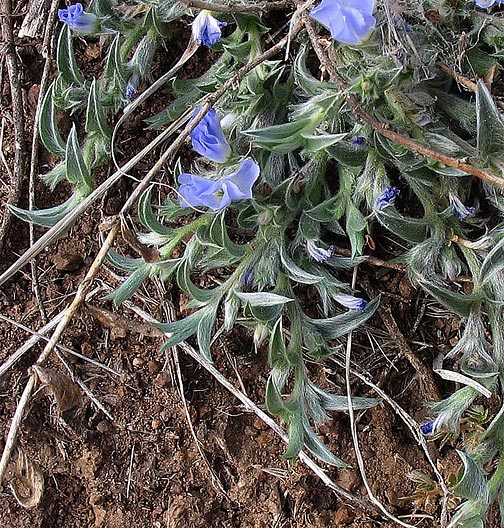
This E. discolor from the Davis Mountains with pubescent upper leaf surfaces and blue flowers will key out to E. nuttallianus with nearly all Texas keys.
A ‘Habit-based’ Approach to Evolvulus Identification
The idenfication of Evolvulus specimens, either from photos or pressed herbarium specimens is often clear without a close examination for the morphological details often required by published keys. With few exceptons, by ignoring habit existing keys tend to lead to incorrect identifications.
The primary habit differentiae are (cf. my 2016 key, habit feature key for E. nuttallianus/E. sericeus/E. discolor):
- peduncle length/inflorescence form
Long peduncles with a cymose inflorescence do not occur with E. nuttallianus
- leaf ranking (distichous or not)
Only E. sericeus, E. discolor & E. alsinoides are distichous
- upper leaf orientation (conduplicate, flat, falcate, erect)
E. sericeus & E. discolor: conduplicate, falcate; E. nuttallianus: flat, erect
Features I consider too variable to distinguish the Evolvulus taxa are:
- flower color
- pubescence type (apart from presence or absence of pubescence)
- sepal form
Although only E. nuttallianus sepals are narrowly lanceolate, they are not always so.
Five galleries of herbarium specimen scans are given below, labeled only with numbers so that viewers can attempt to determine for themselves the appropriate species identification.
To check a determination, just move the cursor onto the large image and the determination made by Bob Harms will appear on the image (in a small box), including the most recent different determination made by others (should these not agree). A general location for the specimen will also be given.
- Stem Tips for Evolvulus Identification
- The leaf formation at the stem tips generally provide all the detail needed to distinguish E. sericeus & E. discolor from E. nuttallianus. The series of images in this gallery shows only the top 3 centimeters of a specimen. Flower detail (color) has been removed.
- E. sericeus Types
- 20 E. sericeus specimens illustrating the wide range of forms, including the long pedunculate form (var. cymosus) common in Central Texas. Note the strongly conduplicate, often falcate upper leaves.
- E. nuttallianus Types
- 30 E. nuttallianus specimens illustrating the wide range of forms, including the entirely glabrous form of Hays County. Note that the leaves are essentially flat (never strongly conduplicate), with an erect cluster of leaves at the very tip.
- Selected Western & Mexican Evolvulus Types
- 26 specimens: 11 E. nuttallianus & 15 E. discolor, of which 13 were incorrectly determined to be E. nuttallianus. Forms of E. discolor with pubescent upper leaf surfaces are common in the Trans-Pecos of Texas (as well as throughout Mexico) - as was noted in van Ooststroom's monograph. Compare these plants with those in the two preceding galleries and the next gallery of Mexican specimens.
- Selected Mexican E sericeus Types
- According to van Ooststroom E. sericeus is represented by three varieties in Mexico: the type variety, var. holosericeus & var. discolor (= E. discolor), with flower color varying from white to blue and all varieties having
a form with leaves not glabrous above, appressed-sericeo-villose on both sides, equally dense on both sides or less dense above than beneath.
15 specimens are shown.

